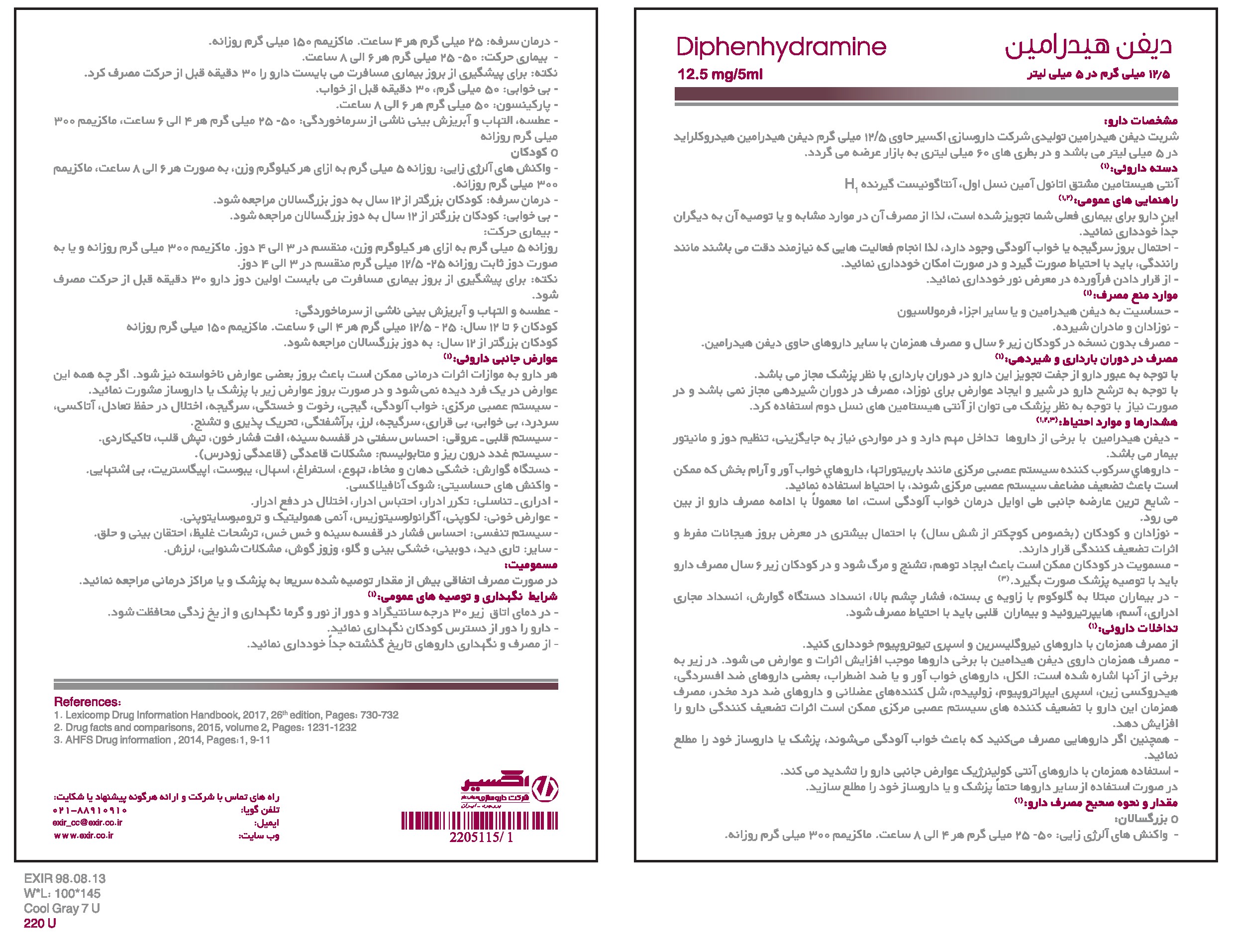Diphenexir
syrup Dyphenhydramine 12.5mg/5ml

| Generic Name of Product | Brand Name | Dosage Form | Strength | Pharmacologic Group | Therapeutic Group | Unit Per Pack |
| Diphenhydramine | - | syrup | 12.5 mg+125 mg/ 5ml (60 ml) | histamine H1 receptor | Antihistamines | 1 |
Indications And Usage | Diphenhydramine is a first-generation H1 receptor antihistamine that is used extensively for the treatment of seasonal allergies, insect bites and stings, and rashes. However, it also has antiemetic, antitussive, hypnotic, and anti-parkinson properties. As histamine receptors exist both peripherally and in the central nervous system, diphenhydramine has been shown to cause sedation due to its competitive antagonism of histamine H1 receptors within the central nervous system. While its use in allergy therapy can sometimes fall out of favor due to its sedative effect, diphenhydramine has been repurposed for use within many non-prescription over-the-counter sleep aids and cough-and-cold medications that have been marketed for "night time" use. Diphenhydramine is also used in combination with chlorotheophylline as the anti-nausea drug Dimenhydrinate where it is utilized primarily for its antagonism of H1 histamine receptors within the vestibular system. Diphenhydramine has also been shown to be implicated in a number of neurotransmitter systems that affect behaviour including dopamine, norepinephrine, serotonin, acetylcholine, and opioid. As a result, diphenhydramine is being investigated for its anxiolytic and anti-depressant properties. |
Administration | Extrapyramidal Reaction Oral: 25 to 50 mg orally 3 to 4 times a day Insomnia : 76 mg orally once a day at bedtime Motion Sickness Oral: 25 to 50 mg orally 3 to 4 times a day Allergic Rhinitis Oral: 38 to 76 mg orally every 4 to 6 hours as needed Cold Symptoms Oral: 38 to 76 mg orally every 4 to 6 hours as needed Pruritus Oral: 38 to 76 mg orally every 4 to 6 hours as needed Urticaria: 38 to 76 mg orally every 4 to 6 hours as needed |
Contraindications | Hypersensitivity to diphenhydramine, other structurally related antihistamines, or any component of the formulation; neonates or premature infants; breast-feeding Parenteral: Use as a local anesthetic. do not use in children <6 years, to make a child sleep, or with any other diphenhydramine-containing products |
Precautions | Asthma: Use with caution in patients with a history of asthma.• Cardiovascular disease: Use with caution in patients with cardiovascular disease (including hypertension and ischemic heart disease).• Increased intraocular pressure/glaucoma: Use with caution in patients with increased intraocular pressure or angle-closure glaucoma.• Prostatic hyperplasia/urinary obstruction: Use with caution in patients with prostatic hyperplasia, bladder neck obstruction, and/or GU obstruction.• Pyloroduodenal obstruction: Use with caution in patients with pyloroduodenal obstruction (including stenotic peptic ulcer).• Thyroid dysfunction: Use with caution in patients with thyroid dysfunction. |
Adverse Reactions | - |
Pregnancy and lactation | B group in pregnancy. Small, occasional doses of diphenhydramine would not be expected to cause any adverse effects in breastfed infants. Larger doses or more prolonged use may cause effects in the infant or decrease the milk supply |
Renal and liver Impairment | Limited pharmacokinetic data are available for the older, first-generation antihistamines. Many appear to be primarily metabolized by the liver, and both parent drugs and metabolites are excreted in the urine. Patients with renal and/or liver disease may be at greater risk for adverse effects from antihistamines due to drug and metabolite accumulation. Therapy with antihistamines should be administered cautiously in such patients. Lower initial dosages may be appropriate. |
Laboratory Tests | - |

